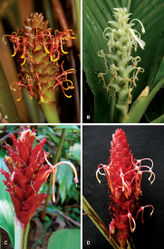Larsenianthus careyanus
| Notice: | This page is derived from the original publication listed below, whose author(s) should always be credited. Further contributors may edit and improve the content of this page and, consequently, need to be credited as well (see page history). Any assessment of factual correctness requires a careful review of the original article as well as of subsequent contributions.
If you are uncertain whether your planned contribution is correct or not, we suggest that you use the associated discussion page instead of editing the page directly. This page should be cited as follows (rationale):
Citation formats to copy and paste
BibTeX: @article{Kress2010PhytoKeys1, RIS/ Endnote: TY - JOUR Wikipedia/ Citizendium: <ref name="Kress2010PhytoKeys1">{{Citation See also the citation download page at the journal. |
Familia: Zingiberaceae
Genus: Larsenianthus
Name
Larsenianthus careyanus (Benth.) W. J. Kress & Mood comb. nov. – Wikispecies link – IPNI link – Pensoft Profile
Latin
Basionym: Hitchenia careyana Benth. (Gen. Pl. 3: 643, 1883).
Type
India: “Mts Sillet, Francis de Silva and William Gomez”, 1832. Wallich Cat. Herb. Ind., 6595 (as Curcuma careyana in Wallich [1832]; lectotype [designated here]: K!; isolectotypes: E!, BM!).
Description
Evergreen herb, medium-sized to 215 cm tall; rhizome to 2.5 cm in diameter, fibrous, fragrant, inner color with an outer white layer and inner dull white layer, roots 5 mm in diameter, yellow; tubers absent. Leafy shoots 10–30, densely clumped, stems 3–4 cm in diameter at base. Leaves 7–9 per stem, increasing in size upward, to 40 cm in total length; basal leaf sheaths 3, glossy, dark green with sparse hairs, turning brown; petiole 0–2 mm in length; ligule 7–8 cm in length cm × 4 cm in width, semi-transparent, green turning brown, densely pubescent with short hairs, apex rounded to truncate; lamina 36–60 cm in length × 18–19 cm in width, ovate to elliptic, surface broadly corrugate with prominent veins, dark green, glossy, glabrous, abaxial side dull green, glabrous, midrib with few hairs, margin hyaline, ciliate, base acute, apex acuminate. Inflorescence terminal on leafy shoot, erect to 35 cm in height, apical part of peduncle 11–12 cm in length × 1.2–1.8 cm in width clasped by the top two leaf sheaths, light yellow-green, glabrous; spike cylindric, 22–25 cm in length × 6–7 cm in diameter; inflorescence bracts up to 60 per inflorescence, 3–4 lower bracts sterile, individual bracts ovate, 3.5 cm in length × 3 cm in width, green with a broad white edge, glabrous, striate, inside smooth with copious, sticky mucilage, apex mucronate reflexed 90°, margin hyaline; 1–3 adventitious plantlets produced in sterile bracts at base of old inflorescence; cincinnus 1 per bract; flowers mature from base to apex of inflorescence. Bracteoles lanceolate, cymbiform, not tubular, keeled with uneven sides, 25–28 mm in length × 5–15 mm in width, striate, yellow-tan, apex truncate to slightly acute. Flowers conspicuous, 4–6 per bract; calyx tubular, 10–18 mm in length, trilobed, white, transparent, glabrous; floral tube 45–52 in length × 1–2 mm in diameter, white, glabrous, deflexing 45° toward rachis in last 10 mm, lobes 3, linear-lanceolate, 15 mm in length × 10 mm in width, greenish-white with pink apex, dorsal lobe recurved 180° against corolla tube, ventral lobes deflexed downward, twisted, almost parallel with labellum; lateral staminodes 2 mm in length × 2 mm in width, suborbicular, white, irridescent, reflexed, apex truncate, pink, glabrous; labellum 24 mm in length mm × 6 mm at the widest, elongate, oblanceolate, white to light purple-pink, iridescent with reflective cells giving a sparkle effect, apex truncate, bidentate at center; fertile stamen with filament 2.3 cm long, forming a 180° arc, ending c. 1 cm above labellum, white; anther 5 mm in length × 3 mm in width, oblong, pollen white; epigynous glands two, cuneate, 5 mm in length × 1 mm in diameter, yellowish; stigma, c. 1 mm long, apical opening with hairs, white, extending 2 mm beyond thecae; ovary trilocular. Fruits 2.0 cm in length × 1.0 cm in diameter, capsular, dehiscing into three separate coiled sections; seeds 8–10, 5 mm in length × 3 mm in width, shiny green, enclosed in a thin, tripartite, cocoon-like fused aril.
Distribution
Bangladesh and northeastern India (Assam, Meghalaya, Arunachal Pradesh, Manipur).
Ecology
Larsenianthus careyanus is found in tropical semi-evergreen forest.
Etymology
This species was originally named by Wallich for the botanist Dr. William Carey (1761–1834).
Specimens examined
India: Arunachal Pradesh: Lohit Dist., 15 September 1969, A.S. Rao 47859 (CAL!); Tirap F. D., 10 November 1959, R. Seshagiri Rao 20004 (CAL!). Assam: Dulong Reserve Forest, 21 November 1957, G. Panigrahi 11283 (CAL!); Kabakhal Reserve Forest, 9 January 1957, R. Seshagiri Rao 9077 (CAL!); Kakoi Reserve Forest, N. Lakhimpur, 13 May 1966, D.M.Verma s.n. (ASSAM!). Manipur: Thirighat, February 1906, A. Meebold 10817 (CAL!); Thirighat, November 1907, A. Meebold 6237 (CAL!). Bangladesh: (India, East Bengal), no date, Griffith 5627 (CAL!); near Sylhet, from material collected by M. Collins and cultivated in the US Botany Research Greenhouses (#02146), 29 July 2003, W. J. Kress 03-7403 (US!).
Taxon Treatment
- Kress, W; D. Mood, J; Sabu, M; Prince, L; Dey, S; Sanoj, E; 2010: Larsenianthus, a new Asian genus of Gingers (Zingiberaceae) with four species PhytoKeys, 1: 15-32. doi
Images
|
